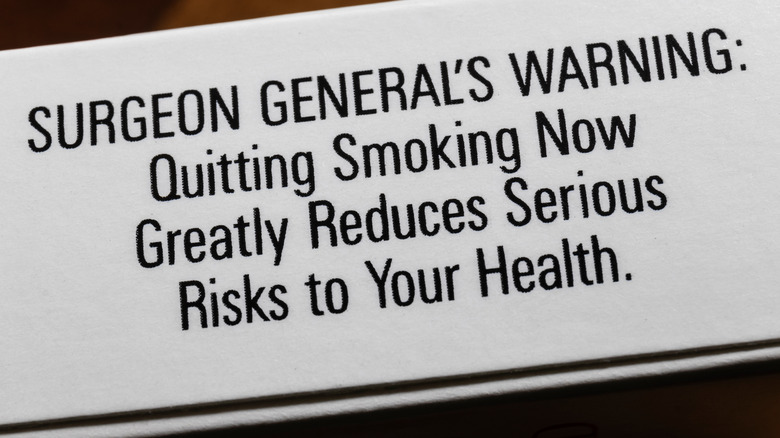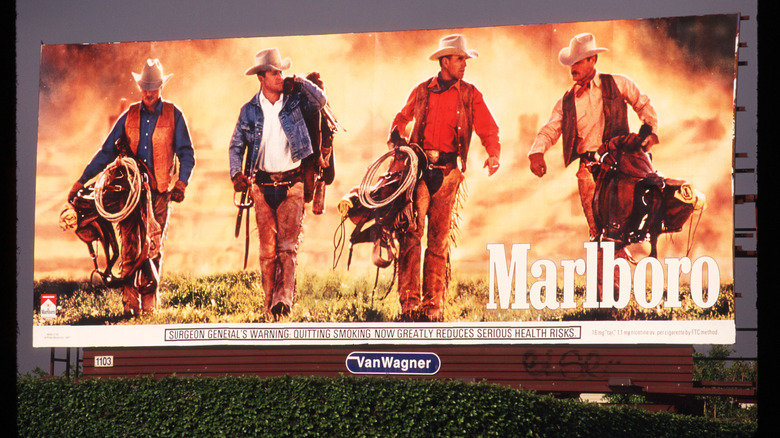Why They Don't Advertise Cigarettes On TV Anymore
People of a certain age likely remember the time when cigarette commercials were all over television. From the Marlboro Man's portrayal of a rugged cowboy lighting up after a long day working on the ranch to Fred Flintstone telling Barney Rubble how Winstons deliver flavor "20 times a pack" (via YouTube), these ads were ubiquitous and evocative of a long-gone era where real-life Don Drapers reigned supreme on Madison Avenue. These days, you wouldn't remotely expect to catch BoJack Horseman (who was seen smoking quite a few times on his eponymous Netflix adult animated series) or Peter Griffin hawking Camels or Lucky Strikes, but decades ago, even cartoon characters were extolling the perceived virtues of taking a drag on a cigarette.
Thanks to countless surgeon general's warnings, as well as the graphic images of cancer patients that are often plastered on packs, we know that smoking cigarettes is dangerous to your health, and could cause a wide range of potentially fatal illnesses, including, but not limited to various forms of cancer. That's the simplest way to explain why cigarettes are no longer advertised like they used to be. But going beyond that basic explanation, we also need to look at the events that led to cigarette commercials getting banned for good in the U.S.
Public health advocates felt surgeon general's warnings weren't cutting it
The push for reforms in the advertisement of tobacco products had started well before all the modern-day tools that have been used to discourage people from buying these items. According to History, some of the earliest reforms came in the 1950s, when it became illegal in all U.S. states for minors to purchase cigarettes; in the 1960s, cigarette makers became required by federal law to place warning labels on their products that read, "Cigarette Smoking May be Hazardous to Your Health."
However, if you come to think of it, that didn't seriously deter adult buyers from buying Marlboros, Winstons, Camels, and Luckies at their nearest convenience store ... or discourage underage smokers from sneaking ciggies out of their parents' packs and lighting up in the bathroom between classes. After all, TV commercials and radio ads were still making smoking look like the cool, macho, and/or sophisticated thing to do. So with that in mind, public health watchdogs felt that those surgeon general's warnings were far from enough to dissuade consumers, especially young people, from smoking.
With the cries from anti-smoking advocates growing louder as Americans young and old kept engaging in the nasty habit, President Richard Nixon signed legislation on April 1, 1970, that prohibited the advertisement of cigarettes on television and radio. Prior to this, Big Tobacco valiantly tried to counter the growing amount of medical literature suggesting that cigarette smoking is addictive and dangerous to one's health, but in the end, it wasn't enough, as Nixon — himself a pipe smoker — agreed that the radio and TV ads had to stop. Nine months later, at 11:50 p.m. on January 1, 1971, the last televised cigarette ad in the U.S. aired during a commercial break on "The Tonight Show Starring Johnny Carson."
Cigarette ads still exist elsewhere ... much to the chagrin of anti-smoking groups
Although 1971 marked the end of an era for cigarette ads on TV and radio in the United States, Big Tobacco still had some weapons in its marketing arsenal. Cigarette advertising continued as normal in newspapers and magazines, as it did on billboards and on public transportation. Fifty years later, cigarette makers still advertise their products through these means, though thanks to a number of subsequent reforms, such ads don't appear as often as they used to, nor are they crafted in such a way that young people may find them appealing. For one, 1998's Master Settlement Agreement, which was signed by 46 states (via Truth Initiative), banned transit and billboard ads for tobacco products, as well as cigarette maker sponsorships for major concerts and other events, and advertising tactics that target underage consumers, including the use of cartoon characters or mascots such as Joe Camel and the Marlboro Man.
While a 2005 agreement saw cigarette manufacturers agree to pull tobacco ads from school library editions of Time, People, Newsweek, and Sports Illustrated (via Consumer Affairs), R.J. Reynolds was back at it in 2013, bringing back advertisements to at least 24 publications after a five-year hiatus. A company representative seemed to emphasize that this was done with the intent of promoting tobacco products to adult buyers, but in a joint statement, five leading U.S. health organizations decried the move, pointing out how the strategy could potentially convince youngsters to take up smoking. "R.J. Reynolds cannot be allowed to get away with yet another marketing campaign that entices America's kids into a deadly addiction," they lamented, as quoted by The Drum.


